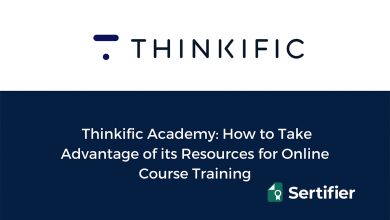Create and Sell Online Courses
This is an essential guide on how to get started with creating and selling online courses!
An online course is a great way to earn money or grow your business. If you’re an expert in a particular topic, selling online courses can be an excellent way to make money while sharing your knowledge and helping others learn new skills.
Online courses are the next big thing, and every niche is getting filled up. If you’re new to selling online courses, this article will help you get started on the right track.
What Is An Online Course?
First thing first. What is an online course? An online course is a course that can be taken over the Internet. It may be created by an individual, a small group of individuals, or even a large organization. You can teach anything from writing a blog post to learning how to build a chair from recycled objects! Online courses may utilize video lectures, text-based material, audio files or any combination of these. Courses are often taught using a learning management system (LMS) that allows students to access their assignments and materials from anywhere.
There are many reasons why you should be selling online courses. You can earn passive income from the sales of your online courses if you do it right. Passive income is when you get paid repeatedly for the same work.
Creating and selling an online course can be easy, but it’s best to have a plan of attack before you start making it. Creativity is always best when we guide it by a system like this outline that we created for you!
What Are the Different Types of Online Courses?
Your goal, budget, and audience determine which type of online course you choose to create. If you are an expert in a particular field and want to make money out of your knowledge and skills, teaching online is the best way. But with so many options available, it’s hard to figure out what would work best for you and your students.
There are many online courses available, but the types of online courses may vary based on the teaching-learning platform. This part of the article will discuss the various types of online classes and how they help students learn better.
Here are the five main ways of teaching online:
Video Online Course
An online video course is your typical online course that people think of when they hear the word “course”. It can consist of recorded videos, audio lectures or any other content that is delivered via video format. They can be watched at any time and asynchronously, meaning that you do not have to watch them live when they are delivered.
These are the most popular online courses, and it’s the easiest to create and distribute. You will be making videos (either with yourself speaking directly to the camera or a more professional video with slides), which you will host on sites like Udemy or Skillshare.
For this type of courses, you need good equipment (usually not too expensive), a microphone, and software to edit your videos.
Interactive Online Course
This format allows students to interact with the instructor and other students within the course platform itself. They can ask questions, get feedback, and participate in group discussions within their course site. This helps build a community amongst students who share similar interests and goals and allow them to learn from each other’s experiences and knowledge.
An interactive online course is one where people sign-up and participates in an online class with a live instructor who guides them through the course content in real-time. Typically, these courses will be presented via webinar software but can also use Google Hangouts or Zoom.
This method is something that you could use in conjunction with a video course – it’s simply an additional way of interacting with your students or customers, who can access the course at any time they want and interact with it at their own pace. While video lessons are usually one-way communication only, interactive courses allow you to engage with people who took the course, by adding discussion and Q&A sessions. This is also an opportunity to get to know other students taking the course with you. You can also create worksheets or quizzes or even use Google Forms or SurveyMonkey surveys at each lesson point. This allows students to engage with the content and learn better as they go along rather than just listening passively. It also gives them something to refer to later, which helps with retaining information.
Webinar
A webinar is presented live and online. The presenter can be anywhere in the world but will present to a group of learners. Learners don’t have to travel and can participate from anywhere they have a computer and an internet connection.
In a webinar, the teacher conducts live sessions with a large group of students. The sessions can be recorded and uploaded on an e-learning platform for future reference. Multiple people can attend a single webinar. This is especially useful when conducting workshops or training programs which expect many people to participate. Webinars are conducted on special software that supports such features as screen sharing and chat boxes. The teacher can also use polls, quizzes, and questionnaires to interact with the students during live sessions.
One-to-One Online Training
This type of training requires one person as a teacher and another as a student. Here, no live class or video conferencing is involved — instead, the teacher uses several tools like Skype to conduct lessons for their students. This method is particularly preferred when students are trying to learn a new skill and wants more personalized instruction. That’s why many instructors teach in one-to-one sessions, where they work with each student individually. One-to-one training gives students more attention and can help them progress more quickly.
These sessions range from 30 minutes to 2 hours and can take place with the help of a free tool like Skype or Google Hangouts. They are one of the best ways to provide personalized training and coach your students.
Boot Camp
Boot camps are commonly found in physical settings but can also be done online. They are designed to give students a complete overview of their chosen subject area in a short amount of time.
Boot camps are a great way to give an online course if you have a course that people will take over several days (or weeks). You set up calls and content in advance, and students go through them as they sign up for the program. It’s also a great way to build community, as students share their progress.
For example, coding boot camps aren’t technically online courses, but they’re becoming more popular among people who want to learn new skills without investing in a four-year college degree. They’re prevalent for people who want to learn coding skills for use in web development, mobile development, data science, etc. Boot camps typically last anywhere from 3 weeks to 6 months, with some offering additional job placement services or mentors.
Hosting these types of courses is easy – you only need to find participants, organize the program, and make sure your technology works appropriately (which is the most challenging part). The process is similar if your target audience is not just individuals but also companies. Then it’s also called corporate training.
In addition to organizing the training itself, there’s another critical aspect: selling it! Usually, this is done by sharing the sales page on social media and via email marketing. Still, many coaches also use pay-per-click advertising to attract customers through Google Ads or Facebook Ads. Furthermore, you need to create all the material yourself, which might be challenging if you have no experience designing digital products.
How To Create An Online Course?
Everything seems fine so far, right? So, how can you create an online course? This article will outline how to make an online course step-by-step.
Creating an online course is a lot like building a house. To do it successfully, you need a plan and the right tools for the job.
We’ve created this guide to help you break down the process into smaller steps that are easy to follow. If you’re still not sure where to start, we recommend going through each of these steps.
Choose a course topic
If you’re thinking of creating an online course, choosing a profitable course topic is the first step. It’s essential to pick a specific topic that your audience will be interested in, rather than to go too broad.
Do you have a topic in mind? How will you create content for this topic? Will people buy it? Is there a possibility that your course will fail?
To answer these questions, you should research before deciding on a course topic.
Many online teachers get so excited to teach that they forget one thing: their students. There’s a saying in the online world: “You can build it, but will they come?” Your students won’t come if you don’t tap into what they want to learn.
The best way to find out if there is demand for your idea is by using Google Keyword Planner: Let’s say you wanted to create a course on making pizza at home. You can type “make pizza at home” into Google Keyword Planner and then cherry-pick the keywords with the highest search demand for your online content. This is the simplest way to ensure that you have enough students interested in your online course topic and enrol in your course. It will provide you with a good idea of what people are looking for online.
Evaluate your skills, strengths, and weaknesses
To get from “I want to make a course” to “here’s my first course,” you need to break down the process into manageable steps.
Before you dive into creating your first course, take some time to evaluate your skills and define your goals. In the long run, this will help you identify what you’re good at, what you’re not so good at, and what you need to learn.
For this, you need to do some self-analysis. If you want to become a successful online course instructor, you need to learn how to evaluate your skills and strengths before creating your online course. Then, you can figure out how to turn them into profitable online courses.
Build your courses around your expertise
Before creating your first online course or starting a business based on your expertise, it’s important that you evaluate your current skill set. How much do you actually know about the topic? Are there any weak areas in your knowledge that need to be addressed? Are there any other subjects related to the topic that would help you become more well-rounded? If so, then consider reading relevant books, taking some classes, or completing a certificate program to learn more about it.
Work on the content
The content of your online course is the most important aspect of creating an online course. Content is “the total sum of everything that you take in over a period of time.” Therefore, when creating an online course, you should think about the content that you are going to provide.
It’s important that you start with a framework when you create your course. The structure will help you stay on target and make sure that the content flows from one training module to another. You should also create a video script for each video in your course if you are planning to create an online video course. This allows you to make sure that the content is easily understood and spoken in a clear and concise manner. You can also use transcripts for each video so that people who don’t speak the language you’re speaking or have hearing disabilities can enjoy your material as well.
It’s important to know that your online course doesn’t have to be amazing right away. You don’t have to put in a ton of work before you even launch it. In fact, it should be the opposite – work on putting out content as soon as possible and then continue enhancing your course with new content as you go along.
We’re not saying that you shouldn’t take the time needed to create a solid online course. What we are saying is that many people get caught up in perfectionism when it comes to the content. Often, they spend too much time making their courses perfect when they could be selling and earning money from it instead.
Identify your audience
One of the most common mistakes people make when creating an online course is not defining their target audience before jumping into the content creation process. As an online instructor, it’s important for you to spend some time thinking about who your target audience is before you start creating your course.
In this part, we will show you how to find your target market, do your research and create an online course that fits their needs.
The most important step for creating a course your target audience will love is validating that idea first. You can validate the need for your course by creating a survey or posting in relevant Facebook groups to see if there’s interest.
Once you have validated the need for your course, use these techniques to research essential information about your target audience:
- First, create buyer personas based on the data you’ve gathered so far about who would be interested in taking your course and why.
- Then, take a look at other courses that are similar to what you want to create. See what people are interested in.
When you do that, you’ll have a successful course launch and happy students!
Use a storyboarding technique to get started creating content
When you create your online course, you want to make sure that you plan out all the content in detail before you start creating it. There are several ways to lay out the content for your online course. We’re going to walk you through the steps of how to create a course outline and structure the content into steps. Even if you don’t currently have all your content, you can begin planning out all your lessons and quizzes in advance. If you have experience teaching in person, you may have used a lesson plan format. But if you’re new to creating an online course, it can be difficult to know where to begin. We’ll show you an easy way to get started with a storyboard technique.

Why storyboarding?
Many people think that planning is boring and unnecessary when it comes to creating online courses. But if you really want to build a great online course, putting in the time to plan out what you’re going to include in each lesson will save you time and frustration down the line.
When you’re writing an eBook, you have all the time in the world to get everything down on paper. Your content can flow freely, and you can always go back and edit anything later. But with an online course, it’s not enough to just write down what you want people to learn from your course. You need to structure your content so that it flows naturally from one lesson to another, and you need to create activities for your students so that they can process what they’re learning.
Storyboarding is a technique that filmmakers use to plan out the total visual effect of a movie. It helps them figure out how to sequence their shots to tell a story, and it’s a great tool for getting started with creating your online course. Storyboarding is an easy way for you to structure the content in your online course as well as plan out all the lessons and activities in advance. It involves creating small sketches or illustrations of each scene in a film or book so that the author can visualize the flow of events before they get started.
Why should you use a storyboard for your online course?
Storyboarding is an excellent way to plan out the structure of your online course in advance. It allows you to build your content from the ground up rather than starting from the beginning and working towards the end as you go along. This helps ensure that you can:
- Create a structure for your course that makes sense for your students and how they learn best.
- Focus on building lessons that are relevant to each part of your course’s overarching goal.
Start by writing down all the topics you want to cover in your course. Don’t worry about the order or how they fit together just yet – just list out all the key ideas you want to cover. If you’re trying to decide which topics to include, pay attention to these:
- Most relevant topics for your target audience
- Topics that will help them solve their problems and achieve their goals?
Map out the modules of your course
The best online courses are well organized and easy to follow. They have a clear structure with a beginning, middle, and end. Creating a course outline is an important task that helps you accomplish this goal. Building your course outline in a logical sequence requires you to plan out the right learning experience for your students. You can start with creating sections for your course outline. This is the best way to organize your content.
- Sections
Sections are the top level of organization in a course. They’re used to group related modules together. For example, if you’re teaching a course on writing, you might want to have sections for each type of writing: fiction, nonfiction, poetry, etc.
- Modules
Modules are collections of lessons that support a common topic or theme. For example, a module might be “Introduction to Python.” It would contain lessons such as “What is Python?” and “Why should I learn Python?” Modules help you organize your course into logical units and make it easier for learners to navigate through your course.
Course modules are designed to make it easier for students to navigate through your content. They provide a logical structure that leads students from one concept to another, and from one module to another. In this way, they guide students through your content in a way that’s consistent and easy to follow.
A good course needs to be easy and enjoyable to consume. This is where instructional design comes in. Instructional design is the art and science of creating a great learning experience. The modules should be short and to the point. If you need to, break them into sub-modules, or topics. The title of each module or topic should be straightforward, so that it is clear what students will learn in each one.
Order your modules logically, so that they build on each other in a way that makes learning easy for students. When you are planning your course and deciding what content to include, always keep your students’ needs in mind.

You need to answer three key questions:
- What are the learning objectives of the course? What specific skills will my students be able to use when they complete it?
- How can I optimize student engagement and learning? What activities and experiences can I use to facilitate student learning?
- How can I deliver a high-quality course? How can I ensure that the content and resources are of the best possible standard?
The first two questions are about building an effective learning environment for students, while the third is about optimizing your own experience as an instructor. The goal is to create a course that meets all three objectives – student satisfaction, instructor satisfaction, and effective learning outcomes.
After you map out how each module will fit together to create the full learning experience by using the storyboard technique, you can step forward!
- Lessons
Lessons are what students will progress through inside each module. Creating an outline with sections and modules before adding content helps you plan how you’ll organize your content ahead of time instead of trying to rearrange things later.
- Choose a video recording software
To create engaging, successful online courses, you need to have a plan and the technical knowledge to follow through. Editing and uploading videos is a technical process that requires advanced skills and equipment. If you’re just getting started with online courses, you might find it best to use a service like Udemy or Skillshare to host your videos online.
If you want to take this step on your own, however, there are several video recording software options out there. We’ll cover the most popular in detail below.
There are two different ways of creating an online course: recording the content live or recording and editing it afterwards. Both have their pros and cons.
- Live video recording involves setting up a camera and giving a presentation to your audience in real time. It can be an effective tool for explaining complex ideas quickly, but it can also lead to awkward pauses when you’re trying to explain something. It’s also very difficult to cut out of the recording if there’s a technical problem, so you must be prepared to re-record the whole thing.
- Recording and editing videos after the fact is much easier. You can do it in one go and make sure you don’t miss anything by using proofreading software (such as Microsoft Word or Cyberduck) on your text file before uploading it to your host site. You’ll still need access to your camera and microphone, but once you’ve got everything in place, you’ll be ready for the next session — no fussing over equipment beforehand or trying to fix a video that gets stuck because of a malfunctioning mic.
You’ll need to choose the right video recording software for you and create a system for recording your course content. Consider these aspects as you choose the software:
- Ease of use:
This is especially important if you’re recording a lot of different classes, which can add up quickly. Video-editing programs are available that can manage hundreds of different files at once, but if you’re doing this on a regular basis, you might want to look into something that lets you organize things more efficiently.
- Video quality:
You don’t want users to be distracted by poor quality videos or sound because they’ll get bored and leave your site. Try out different tools and see what works best for you; some offer automatic editing features to reduce unwanted noise.
- Recordings:
If you’re doing more than just showing slides, you’ll need different options for recording lectures than if all you want is a quick screencast. Keep it simple so that your recordings will be compatible on other platforms (such as Facebook or YouTube).
Before shooting your first video, make sure to test out your equipment and other factors related to creating and uploading videos. Before starting any recording session, make sure that you have all the files you need ready in advance so there are no interruptions during the actual shoot!
Choose a delivery platform for your course
When you start your online course business, you want it to be accessible and affordable for customers. This means you need a way to sell courses online and receive payments for them.
In this section, we’ll go over the basics of how to get your online course up and running:
- Develop your course using the right tools and templates
- Select a platform to sell your course that fits your needs and budget.
- Acquire an eCommerce platform so you can receive payments for your courses.
- Submit your course to listing websites.
Luckily, there are lots of places where you can accomplish all those tasks without having to build them yourself (and without spending a lot of money). Here are some of the most popular options for selling online courses:
There are several reputable services that make hosting and selling courses easy, but there are pros and cons to each one.
Create a course welcome video
A course welcome video or an introduction can be a great way to start creating your course page and to helo, your students know more about you and your expertise. Show your students who you are. Let them know what they’re going to get out of the course, but also let them know who you are and what your personality is like. Students are more likely to act if they trust the instructor.
Create a course welcome video. Let your students have a general idea of what they should expect from the course by creating a welcome video. It could include steps and modules and what will they gain after completing the course such as digital certificates or anything else that might be useful for them?
The welcome video is the first thing your students will see when they enrol in your course. Have a welcome video that highlights what they should expect from the course.
Don’t ask for too much information upfront. Don’t ask for too much information all at once. Break it up into smaller segments or sections and spread it throughout the course. If you ask for too much information all at one time, it can be overwhelming and cause students to drop out before they even really get started.
Make sure your first lesson is action-oriented. After an introduction video, give your students something that they can do right away so they feel engaged in the material. You want them to act as soon as possible so they don’t forget what they were going to do or lose interest in the course altogether.
Determine how you want to price your online courses
Now that you have your course content and the technology to deliver it, what’s left is to set your price and market your course.
When you’re first starting out, it can be tempting to offer your courses for free. But that’s not a sustainable business model if you want to make money online.

When it comes to pricing an online course, there are several factors that you should keep in mind:
- The quality of your content
- The quality of the learning experience
- The value your students get from taking this course
- How much time and effort do you want to put into pre-sales marketing, customer support and fulfilment operations
- How much money do you want to make from each student
Basically, you’ll need to figure out how much your course is worth, and how much you want to sell it for.
- 80/20 Rule:
For every twenty potential students, only four will sign up for your course. Of those four people, one of them will probably ask for a refund inside of the 30-day period. So, you’re really making money off just three out of those twenty people, or 15%.
If you charge $100 for your course, that means you’ll make $15 per sale. You could also price it at $150 and make $22.50 per sale.
- Cost of Goods Sold:
Another way to determine what your online course will cost is by using a cost of goods sold (COGS) formula. This formula takes into account the various costs that are associated with creating a quality online course, such as the cost of the materials required for your course, the time that it takes you to create the course, etc.
Once you have a good idea of how much it will cost you to create each unit of your online course, you can begin determining your pricing strategy. The easiest way to do this is by considering how much it would cost for someone else to provide the same services (your competition). Use this information as a starting point when determining prices for your own products and services.
To get your pricing right, you need to understand what your audience needs to know, how they want to learn it, and how they want the content to be delivered. Your goal is to answer all these questions so that you can create a product that people will want to buy at the price you want to sell.
What about the pricing model? There are three main pricing models for online courses. The best way to choose which one works for you is to look at your goals and personal situation. If you’re still not sure, then we’ve listed some pros and cons for each model below.
The three pricing models are:
- Fixed price courses
- Subscription courses
- Pay-what-you-want courses
It’s up to you to decide what makes the most sense based on your goals.
Now everything is settled right? We planned an amazing online course! One important step left though. You may have an awesome course, but if nobody knows about it (especially in the beginning), why would anybody buy it? Spend some time creating sales pages that sell and add some marketing around them to get potential buyers interested in what your course has to offer.
Create content around your online courses
It’s great that you are thinking about creating a marketing strategy for your online course. It’s very important to plan how you will promote it to reach more students and make more money.
Marketing your courses is a huge task. It’s one that many people feel overwhelmed by and end up leaving to the last minute.
Here are some points that might be helpful for you throughout to process:
- Promoting your online course through content marketing (blogging).
- Warming up the platform – Start creating content on the topic you are passionate about, so that you can gain some followers/fans.
- Scaling up your profit with proven digital marketing strategies.
- Growing up your email list with contests and giveaways to create an e-mail campaign.
Build social media profiles
Social media can be an effective way to promote your business and engage with your existing and potential customers, and it is a great way to promote your course before the launch. When you are planning to create and launch an online course, using social media is a smart way to promote your business, engage with your audience, and grow your network. If you have an existing course, you can use social media to generate more sales.

Why Should I Use Social Media For Online Courses?
Social media is an amazing way to market your business. Not only does it provide a direct line of communication with the people who are interested in what you have to offer, but it also gives you an opportunity to build brand awareness and customer loyalty by providing content that educates, inspires, and entertains.
The biggest benefit of social media is that it’s free (well, mostly). Twitter and Facebook are completely free platforms that allow you to reach a wide audience of potential customers. Other social networks like LinkedIn, YouTube and Instagram have free options as well as paid ads that can help drive users back to your website or landing page.
Another advantage of social media is that it makes it easy for people to share your content with their own friends and followers. In fact, most platforms have built-in sharing buttons, so users don’t even need to leave the site to tell others about what they’re reading or viewing.
Overall, it is an amazing way to promote your upcoming or existing online course! If you don’t know how, here are the crucial steps for making the most out of social media during the pre-launch phase:
Set up social media accounts
It makes sense to have a presence in several platforms. Some of the most popular platforms include Facebook, Twitter, Google+ and Pinterest. Set up your social media accounts, follow some people and start sharing quality content about your expertise and your course. It is likely that there will be more response in some platforms rather than others. It means this is where your target audience is active, focus on it!
Promote your course before the launch
Start building buzz around the launch date of your online course by releasing teaser content in several forms (video, audio, blogs) leading up to it. This will help build anticipation for what is to come. For example, if you create 10 short videos on a topic related to your course, share them on Facebook and watch for the feedback of your audience. The comments and reactions will be very useful for creating a better final product.
You can also use social media platforms as places where you can release this information through status updates and tweets. Social media will also be a huge asset in promoting your course once it’s launched so that you get as many sales as possible during the first few days or weeks.
Find and engage new users with advertising
There are more ways to get more people to sign up for your online courses. You can focus on organic or paid traffic, depending on what your marketing goals are and the resources you have available. If you’re just getting started, then your goal might be to get your first signups. Or you might want to help more people in your target audience find you online.
Here are a few ways to do that:
Start with your audience in mind
What are the problems they face? How could you help them? How would they search for solutions online? What websites would they visit? Which social media channels do they use?
Make sure you think them through so that you can actually reach out to your audience.
Set up a marketing plan for your online courses
When you think about a marketing plan, don’t make it more complicated than it needs to be. It’s a roadmap you can use to reach your target audience and get them interested in your course.
You’re ready to launch your new online course, but first, you need to get the word out about it. This is where your marketing plan comes into play.
Focus on SEO by creating great content and doing keyword research
For most marketers, organic traffic from search engines is extremely important to their overall digital strategy. In fact, according to Search Engine Journal, it makes up over half of the web traffic for many websites. That means if you don’t focus on SEO by creating content around your online course, it will really drop your click rates down. Just write and share what you know, it’s your expertise!
Earn publicity through guest posting, interviews, and speaking opportunities
You should find your audience and attract them to your sales page. But why shouldn’t you get some help in doing so? Your audience is out there and probably already reading, watching, or listening to what they want to learn. Try reaching out to your peers who already have a connection with your potential audience and tell them who you are or why they should take your online course.
Run paid advertising campaigns to get more people to sign up for your course
But find the best place to do it. If you are selling a course about how to produce hip hop music, a Facebook ad might not get in front of the right audience for your course. You might be better off running an ad on a music forum or trying to get your course featured in a relevant magazine or blog.
Now is the time to launch!
You are amazing and ready to go if you’ve completed the steps so far! Get ready to launch your new course!
Before you go live, make sure you have all the important details ironed out. Here are a few to-dos before you launch:
- You should have an email list of people who are interested in your content, so let them know! Also, consider creating Facebook ads to promote the course.
- Make sure you get testimonials. If your course has a great reputation already, ask for testimonials from happy students (and don’t be afraid to ask for written ones). Although most people will be happy to provide an endorsement, there’s nothing wrong with being proactive.
- Do you like it? Start working on promoting your next course right away!
Before you go!
We are happy that you took the time to learn more about launching your online course and getting the most out of your efforts. Although we believe you will do great, we can’t guarantee a huge success right away. But we have some good news: The global eLearning market was valued at $165 billion in 2016 and expected to reach $374 billion by the year 2026!
e-Learning is the next big thing. And you won’t ever regret that you started working on it today!






